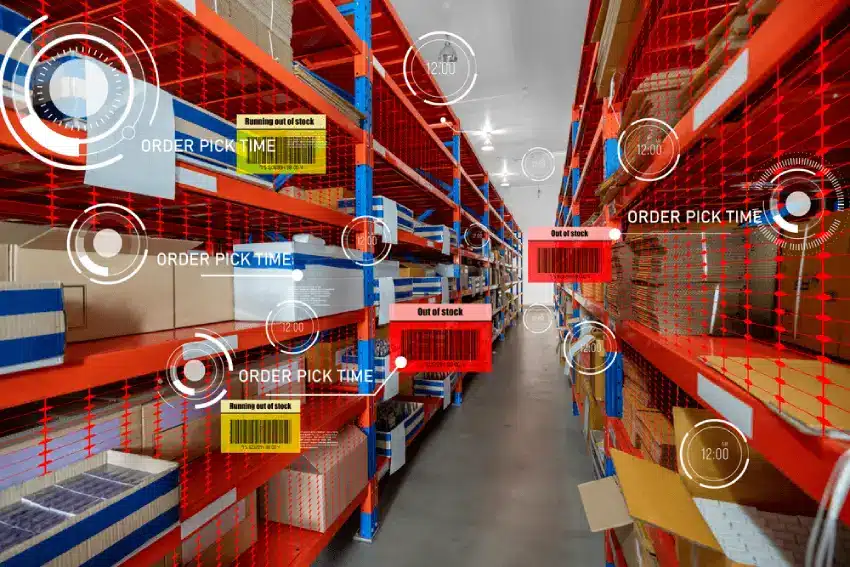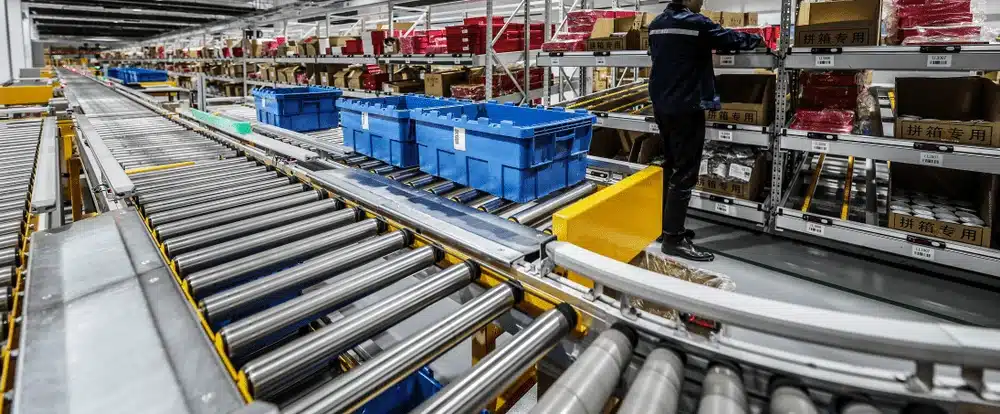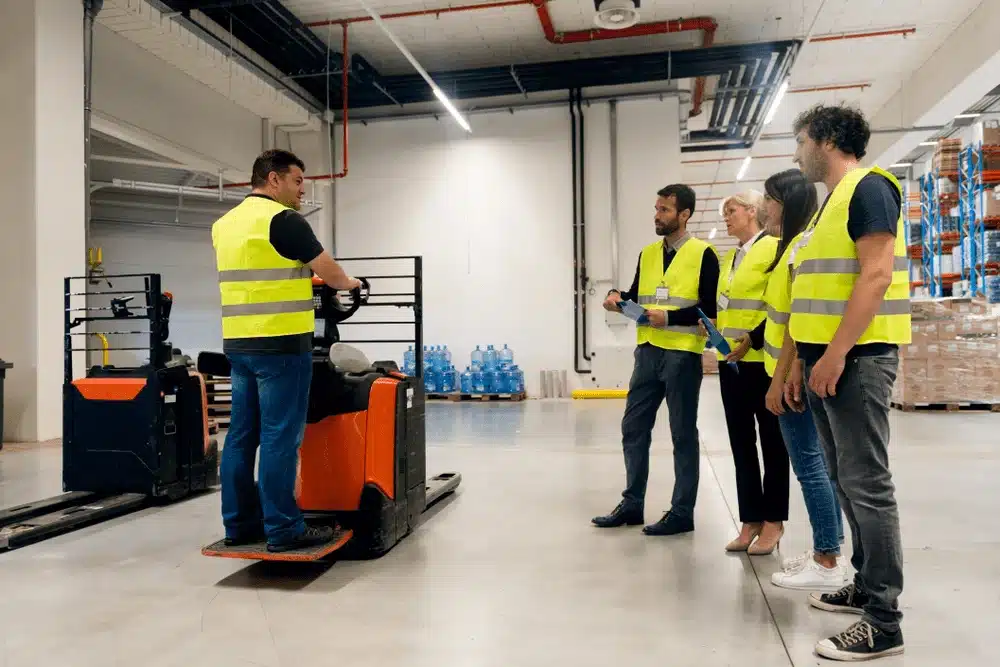
Warehouse picking is a critical and intricate process in the supply chain, often considered the backbone of warehouse operations. It’s not merely about retrieving items; it’s about ensuring that the right products are selected in the right quantities at the right time. This process requires strategic planning, coordination, and flawless execution.
In recent years with the rise of e-commerce and global trade, warehouse picking has become more complex and demanding. With a wide variety of products, ever-shrinking delivery windows, and increasing customer expectations, the picking process must be efficient, accurate, and adaptable.
However, the importance of this function extends beyond the warehouse walls. It impacts the entire supply chain, from inventory management to customer satisfaction. That’s why a well-optimized picking process can be a competitive advantage, while inefficiencies can lead to significant challenges.
This guide will delve into the complexities of warehouse picking, exploring various methods, technologies, challenges, and best practices. Whether you’re a seasoned warehouse manager or new to the industry, this comprehensive guide will provide valuable insights and actionable strategies.
What is Warehouse Picking?
Warehouse picking, also known as warehouse order picking, is the process of locating and retrieving products from storage areas to fulfill customer orders. It’s a vital step that connects inventory management with order fulfillment, acting as a bridge between what’s in stock and what’s being shipped.
But warehouse picking is far from simple. It involves multiple steps, including:
- Identifying the Items: Using order information to determine the products and quantities needed.
- Locating the Items: Finding the exact location of the items within the warehouse.
- Retrieving the Items: Physically picking the items from the shelves or storage areas.
- Verifying the Items: Ensuring that the correct items and quantities have been picked.
- Packing the Items: Preparing the items for shipment, including packing and labeling.
The warehouse order picking process involves each step and must be performed with precision to ensure accurate and timely fulfillment. Mistakes at any stage can lead to errors in the order, delays in shipment, and dissatisfied customers.
It’s important to note that the complexity of warehouse picking can vary depending on the size of the warehouse, the variety of products, the technology employed, and the specific requirements of the customers. From old-fashioned manual picking with paper lists to automated systems with real-time tracking, the methods and tools used in warehouse picking can be diverse and sophisticated.
Importance of Warehouse Picking
The efficiency of warehouse picking directly impacts several key areas of the business:
- Customer Satisfaction: Accurate and timely picking leads to on-time deliveries and satisfied customers. Errors or delays in picking can result in incorrect shipments, late deliveries, and negative customer experiences.
- Operational Costs: Efficient picking processes reduce labor costs, minimize travel time within the warehouse, and optimize the use of resources. Inefficiencies can lead to higher costs and wasted efforts.
- Overall Productivity: Picking is often the bottleneck in warehouse operations. Streamlining the picking process can enhance overall productivity, allowing for more orders to be processed in less time.
- Competitive Advantage: In a market where speed and accuracy are highly valued, an optimized picking process can be a significant competitive advantage. It enables faster response times, greater flexibility, and the ability to meet specific customer demands.
Clearly, warehouse picking is not just a task within the warehouse; it’s a strategic process that affects the entire business. From customer relationships to bottom-line profitability, the way warehouse picking is managed can make or break success.
Looking to Enhance Your Picking Efficiency?
Discover how Logimax can streamline your warehouse operations with advanced picking features. Elevate efficiency with a solution that adapts to your needs while enhancing accuracy and customer satisfaction.
Discover How
Picking Methods
Choosing the right picking method is essential for efficiency and effectiveness in warehouse operations. Different methods are employed to pick orders, ranging from single order picking for specialized orders to batch picking for handling multiple orders simultaneously. The choice of method can significantly impact efficiency and accuracy. Here’s a detailed look at various picking methods:
Single Order Picking
Single order picking involves picking items for one order at a time. It’s a method that prioritizes precision and is often used for specialized or high-value orders.
Advantages: High accuracy, personalized handling, suitable for unique or fragile items.
Challenges: Can be time-consuming, especially in large warehouses with diverse product ranges.
Best suited for: Operations with customized orders, small quantities, or specialized products.
Batch Picking
Batch picking involves picking items for multiple orders simultaneously. By grouping similar orders together, this method enhances efficiency.
Advantages: Reduces travel time within the warehouse, allows for bulk handling, improves productivity.
Challenges: Requires careful coordination, potential for mix-ups if not managed properly.
Best suited for: Operations with high volumes of similar products or repetitive orders.
Zone Picking
Zone picking divides the warehouse into specific areas or zones, with pickers responsible for each zone. This specialization allows for faster picking and reduced travel time.
Advantages: Minimizes travel time, allows for specialization in product categories, and enhances efficiency.
Challenges: Requires proper zoning and coordination between zones, potential delays if one zone falls behind.
Best suited for: Large warehouses with a wide variety of products and operations requiring specialized handling.
Wave Picking
Wave picking combines orders based on specific criteria, such as delivery routes or product types. It’s a flexible method that can be adapted to various operational needs.
Advantages: Optimizes delivery schedules, reduces transportation costs, and allows for flexible scheduling.
Challenges: Requires sophisticated planning and coordination, potential complexity in handling mixed orders.
Best suited for: Operations with diverse delivery routes, varying order sizes, and dynamic scheduling needs.
Considerations for Choosing a Picking Method
As mentioned, selecting the right picking method is not a one-size-fits-all decision. It requires careful consideration of various factors, including:
Order Volume: The number of orders and the size of each order can influence the best picking method.
Product Variety: The range and nature of products can determine the suitability of different methods.
Warehouse Layout: The physical layout of the warehouse, including storage arrangements and travel paths, plays a role in method selection.
Available Technology: The technology used in the warehouse, such as WMS or automation, can enable or limit certain picking methods.
Customer Requirements: Specific customer needs, such as customization or delivery schedules, must be considered.
Choosing the right picking system, whether it’s single order, batch, zone, or wave picking, is essential for the success of warehouse operations. The right system should align with the warehouse’s unique needs, enhancing efficiency, and meeting specific customer requirements.

Technology in Warehouse Picking
Modern technology, including warehouse picking software, plays a vital role in enhancing warehouse picking. From tracking to automation, technology can transform the way warehouses operate. Here’s a quick look at various technologies used in the order picking process:
Barcode Scanning
Barcode scanning enables accurate tracking and verification of items. It’s a foundational technology that has revolutionized warehouse operations.
Advantages: Reduces human errors, enhances tracking, and streamlines processes.
Challenges: Requires proper labeling and maintenance, potential issues with damaged or unreadable barcodes.
Applications: Used in almost all modern warehouses for tracking, verification, and reporting.
Automated Guided Vehicles (AGVs)
AGVs are robotic vehicles that automate the transportation of goods within the warehouse. They represent a significant advancement in automation.
Advantages: Enhances efficiency, reduces manual labor, and allows for 24/7 operations.
Challenges: Requires investment in infrastructure, potential limitations in handling complex tasks.
Applications: Suitable for large warehouses with high volumes, repetitive tasks, and heavy loads.
Warehouse Management Systems (WMS)
A WMS is a comprehensive software solution that manages various warehouse operations, providing real-time insights and optimization. Among these roles is that of warehouse picking software. However, leading warehouse management systems also handle many more functions for warehouse operations of all sizes.
Among order picking features, warehouse picking software can generate and manage picking lists, providing real-time updates and ensuring that pickers have accurate information at their fingertips. Picking lists streamline the process, reducing the likelihood of errors and enhancing productivity.
Advantages: A WMS enables data-driven decision-making, integrates with other systems, provides real-time tracking and reporting through warehouse picking software functionalities.
Challenges: Requires proper implementation and training, potential complexity in customization.
Applications: Essential for modern warehouses seeking to optimize operations, integrate with the supply chain, and enhance visibility.
RFID Technology
RFID technology allows for precise tracking without manual scanning. It represents a step beyond traditional barcodes.
Advantages: Enhances accuracy, reduces manual scanning, and allows for bulk reading.
Challenges: Higher costs compared to barcodes and potential interference with other electronic devices.
Applications: Suitable for high-value items, complex tracking needs, and operations requiring rapid scanning.
Voice Picking
Voice picking allows warehouse pickers to receive verbal instructions through a headset. It’s a hands-free technology that streamlines the picking process.
Advantages: Enables faster picking, reduces errors, and provides flexibility in integration.
Challenges: Requires proper setup and training, potential language barriers for multilingual workforces.
Applications: Ideal for high-volume picking, complex environments, and integration with other technologies like WMS and barcode scanning.

Integration with Other Systems
Integrating picking technology with other systems such as ERP and CRM can provide a holistic view of the supply chain.
Advantages: Enhances coordination between departments, provides a unified view of operations, and enables advanced analytics.
Challenges: Requires proper integration and data management, potential complexity in aligning different systems.
Applications: Ideal for large operations with diverse functions, seeking to enhance overall supply chain efficiency.
Challenges and Solutions in Warehouse Picking
Warehouse picking is a complex process that presents various challenges. Understanding these challenges and implementing effective solutions is key to maintaining efficiency and accuracy. Here’s a detailed examination of common challenges and their solutions:
Challenge: Inaccurate Inventory
Inaccurate inventory can lead to picking errors, delays, and lost sales. It undermines the entire picking process and can have cascading effects on customer satisfaction.
Solution: Implement real-time tracking and regular audits. Utilize a WMS to ensure that inventory data is always up to date. Consider technologies like RF and RFID scanning for enhanced accuracy. Regularly reconcile physical inventory with system records through cycle counts.
Challenge: Inefficient Picking Routes
Inefficient picking routes can cause pickers to travel long distances within the warehouse, leading to delays and higher labor costs. It’s a challenge that often arises in large or poorly organized warehouses.
Solution: Utilize a WMS to optimize picking routes based on the warehouse layout and order requirements. Implement zone or wave picking to reduce unnecessary travel. Consider the use of AGVs for automated transportation.
Challenge: Labor Intensive Processes
Manual picking processes can be labor-intensive, leading to higher costs and potential errors. Over-reliance on manual labor can also limit scalability.
Solution: Labor-intensive processes can be transformed through automated picking, utilizing robotics and automated guided vehicles (AGVs). This not only reduces manual labor but also enhances precision and scalability, making it a vital solution for modern warehouses.
Challenge: Lack of Training
Untrained or poorly trained staff can lead to mistakes, inefficiencies, and safety risks. Training is often overlooked but is vital for success.
Solution: Provide continuous training and support. Ensure that staff are well-versed in the latest procedures, technologies, and safety protocols. Create a culture of learning and improvement.
Challenge: Compliance and Regulations
Warehouses must comply with various industry regulations and standards. Non-compliance can lead to legal issues, fines, and reputational damage.
Solution: Stay updated with industry regulations and ensure that all processes are in compliance. Regularly review and update procedures to align with legal requirements. Consider third-party audits for unbiased compliance assessment.
Warehouse Order Picking Best Practices
Implementing best practices in warehouse picking can lead to consistent success. These practices are not just about solving problems but about creating a culture of excellence. Here are some key best practices:
Implement Proper Training
- Why It Matters: Well-trained staff are more efficient, make fewer mistakes, and contribute to a positive work environment.
- How to Implement: Create regular training programs, provide hands-on experience, encourage continuous learning, and recognize achievements.
Utilize Technology
- Why It Matters: Technology enhances efficiency, accuracy, and scalability. It’s a vital component of modern warehouse operations.
- How to Implement: Evaluate and invest in technology that aligns with operational needs. Provide training and support for successful implementation. Regularly review and update technology to stay ahead of industry trends.
Monitor Performance
- Why It Matters: Regular monitoring helps identify areas for improvement, ensures accountability, and guides strategic decisions.
- How to Implement: Implement regular audits and performance reviews. Utilize Key Performance Indicators (KPIs) to measure success. Encourage feedback and collaboration in performance improvement.
Focus on Safety
- Why It Matters: Safety is paramount in warehouse operations. A safe environment protects employees, reduces risks, and enhances overall productivity.
- How to Implement: Implement and enforce safety protocols. Provide regular safety training. Encourage a culture of safety awareness and responsibility.
Continuous Improvement
- Why It Matters: The world of warehousing is constantly evolving. Continuous improvement ensures that operations stay competitive and aligned with industry developments.
- How to Implement: Encourage a culture of continuous improvement. Regularly review processes, technologies, and strategies. Encourage innovation and adaptability.

Future Trends
The world of warehouse picking is constantly evolving, driven by technological advancements, changing consumer demands, and global economic shifts. Here’s an in-depth look at some future trends that are shaping the industry:
AI and Machine Learning
- What’s Happening: Artificial Intelligence (AI) and Machine Learning (ML) are being integrated into warehouse operations, enabling intelligent decision-making, predictive analytics, and adaptive processes.
- Why It Matters: AI and ML can enhance forecasting accuracy, optimize picking routes, and allow warehouses to adapt to market changes more rapidly.
- How to Prepare: Invest in tools geared to harness AI and ML, collaborate with technology providers, and train staff to work with AI-driven systems.
Robotics
- What’s Happening: Robotics is becoming more common in warehouses, automating routine tasks and working alongside humans.
- Why It Matters: Robotics offers precision, efficiency, and flexibility, transforming the way warehouses operate.
- How to Prepare: Explore robotic solutions that align with operational needs, invest in integration, and provide training for human-robot collaboration.
Sustainability
- What’s Happening: There’s a growing emphasis on environmental responsibility, leading to the implementation of sustainable practices in warehouse picking.
- Why It Matters: Sustainability enhances brand reputation, reduces waste, and aligns with global efforts to protect the environment.
- How to Prepare: Implement energy-efficient technologies, reduce waste through recycling and reuse, paperless systems, and consider sustainability in procurement and operations.
How Logimax Can Help
At Logimax, we understand the complexities of warehouse picking. Our warehouse picking software solutions are designed to streamline your operations, providing tools that align with your unique needs and industry trends.
WMS Solutions
- What We Offer: Our Warehouse Management System (WMS) offers real-time inventory tracking, order picking, route optimization, performance analytics, and more.
- Why It Matters: A robust WMS can transform your warehouse operations, enhancing efficiency, accuracy, and adaptability.
- How to Get Started: Explore our WMS solutions and connect with our team for personalized assistance.
Customized Support
- What We Offer: We provide customized support and solutions tailored to your specific challenges, goals, and industry requirements.
- Why It Matters: Every warehouse is unique, and our personalized approach ensures that you get the right solutions for your needs.
- How to Get Started: Contact us to discuss your needs, and our experts will work with you to create customized solutions that drive success.
Conclusion
Warehouse picking is a vital and complex process that impacts every aspect of the supply chain. From choosing the right picking methods to leveraging cutting-edge technology, optimizing warehouse picking requires strategic planning, continuous improvement, and adaptability to future trends.
At Logimax, we’re committed to helping you navigate these complexities. Our solutions are designed with your success in mind, providing the tools, insights, and support you need to take your warehouse picking to the next level.
Take Action Today: Explore our WMS solutions and contact us to discuss how we can assist you in achieving excellence in warehouse picking. Let’s work together to create a warehouse that’s efficient, adaptable, and ready for the future.



